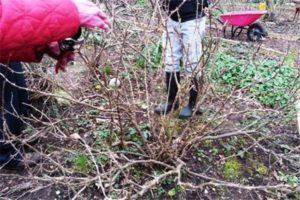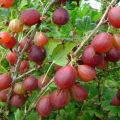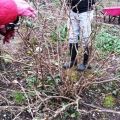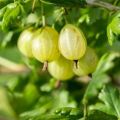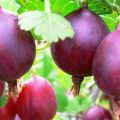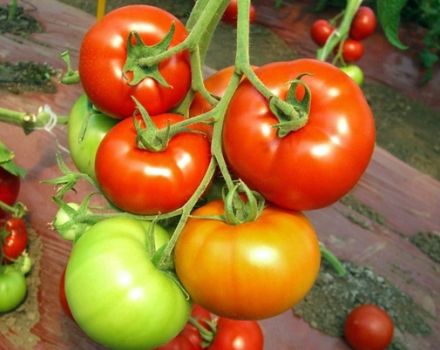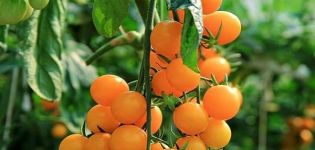Description of the Hinnomaki gooseberry variety and its varieties, planting and care
The gooseberry, which is taken on a stem even in Europe, where the fruit shrub was cultivated many centuries ago, has just begun to attract Russian summer residents and gardeners. The plant, covered with berries, looks very interesting, in the southern regions it winters well in the yard, in the northern regions, having placed it in a container, it is brought into a greenhouse, placed in a loggia. To grow Hinnomaki gooseberries, which have several varieties, on a stem, shrubs are used that are tall.
General information about the variety
The plant, bred by Finnish breeders, has a rounded shape. The Hinnomaki gooseberry forms many thin shoots, studded with thorns, but attracts with large berries, high yield. On the bushes, growing in height up to one and a half meters, at the beginning of July, about 7 kg of oval fruits ripen, delighting with a sweet taste and delicate aroma. Overripe gooseberries do not crack, but slightly pubescent berries fall to the ground.
They are rich:
- organic acids;
- saccharides;
- vitamins;
- microelements.
The fruits make excellent desserts, candied fruits, wine, juice.Hinnomaki is rarely affected by spheroteca. Spider mites, bear, whitefly larvae are not particularly dangerous for the variety.
The merits and demerits of culture
Gooseberries, created in Finland, are hardy, grow very quickly, and do not require special care. The advantages of the Hinnomaki variety include:
- immunity to powdery mildew;
- high resistance to frost;
- the possibility of growing on a trunk;
- excellent fruit quality.
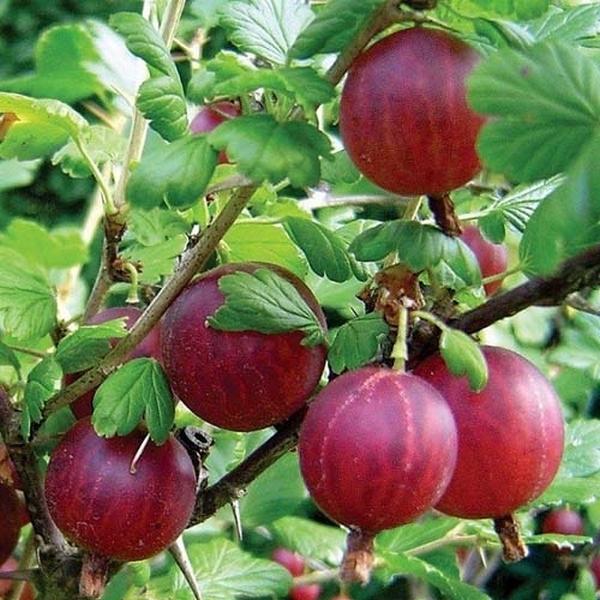
On fertile lands, illuminated by the sun's rays, the shrub gives a rich harvest. The shoots of the plant are densely covered with thorns, about which it is easy to beat off, cutting off the branches, picking berries. And this is probably the only drawback of the shrub.
Varieties of varieties
Finnish breeders, who were engaged in breeding the fruitful gooseberry Hinnomaki, did not stop by creating a shrub with fruits of the same color.
The variety has several varieties that differ not only in the color of the berries, but also in the ripening period and some other characteristics.
Hinnomaki Green gooseberry loves the sun, grows in an area closed from drafts, withstands frosts up to 30 ° C. Weakly spreading bushes rarely reach a height of 1.2 m. Shoots are covered with thorns, which complicates harvesting. In July, oval berries ripen with a sweet and sour pulp of a rich green color.Up to 5 kg of fruits are picked from biennial plants that need to be tied up. The variety is not affected by mildew, it is immune to spheroteca.
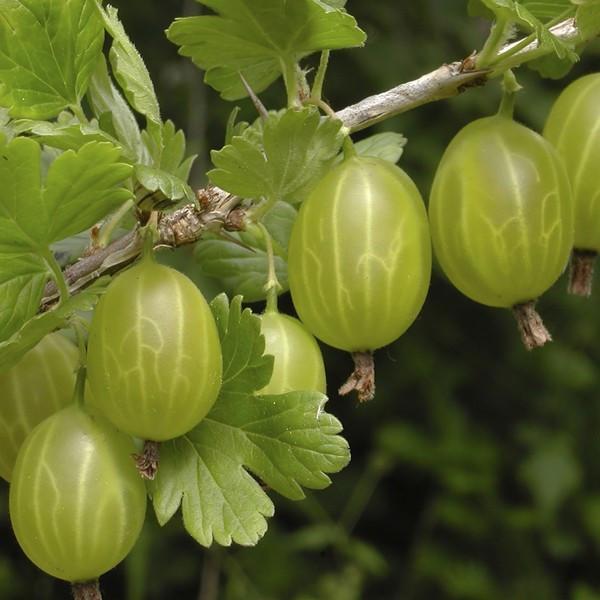
One of the Hinnomaki gooseberry species - Red, forms bushes about one and a half meters high, which are amazingly hardy. The plant does not suffer from powdery mildew; on loams it yields almost 9 kg. The berries ripen in medium terms, some specimens weigh 7–8 grams, when ripe they acquire a dark red hue.
The Hinnomaki Yellow bush cannot boast of its mighty size, its height is 70 cm.The plant takes root and bears fruit abundantly on sands and loams, but does not tolerate swampy acidic soils.The gooseberry blooms very beautifully; with regular pruning, it gives a high yield of sweet and fragrant golden berries.
Another gooseberry variety, Hinnomaki Gelb, withstands both frost and drought, is immune to some diseases, and prefers fertile soil. On the shoots of a compact shrub covered with thorns, male and female green flowers appear in May. They are formed in the axils of the leaves in several pieces.

Yellow berries, ripening in July, have:
- weak pubescence;
- sweet and sour pulp;
- pleasant aroma.
The variety is undemanding to moisture; it does not take root in acidic moist soil. In areas illuminated by the sun, the shrub develops rapidly.
Growing Hinnomaki gooseberries
The description of the characteristics of the berry crop variety bred in Northern Europe interested gardeners from regions with frosty winters and cool summers. The Hinnomaki gooseberry develops well and bears fruit if the site is correctly selected for it. The shrub should be planted on level ground, sheltered from the wind. Do not place the plant near trees.

With a lack of light, the gooseberry loses its immunity to fungal infection and is affected by spheroteca.
Preparing the landing site
The Hinnomaki variety takes root better in the fall. Young plants have time to get stronger before frost, and in spring they begin to actively develop. About 2 weeks before planting, the site is dug up, equalized, weeds are removed with the help of herbicides, organic matter or mineral fertilizers are scattered, and holes are made. The best predecessors for the shrub are siderates in the form of rye and mustard.
Gooseberry soil
The Hinnomaki variety should not be planted in swampy areas where water approaches the surface. Uncomfortable for a plant on podzolic and heavy soils. Loam and black soil are best suited for gooseberries.

Landing scheme
The holes that are dug in the fall should have a depth and diameter of about half a meter. Saplings are placed every 1.5 m, 2.5 is left between the rows. The pit is filled 2/3 with soil, which is prepared by combining:
- a bucket of manure;
- a glass of superphosphate;
- 50 g of lime and potassium sulfate;
- 300 g of ash.
At the bottom of the hole, a mound is made from fertile soil. A seedling is placed on it, deepening the root collar by 6 or 7 cm. The soil around the gooseberry is trampled, half a bucket of water is poured into the groove and covered with humus. Shoots are shortened, which makes it possible to enhance branching.
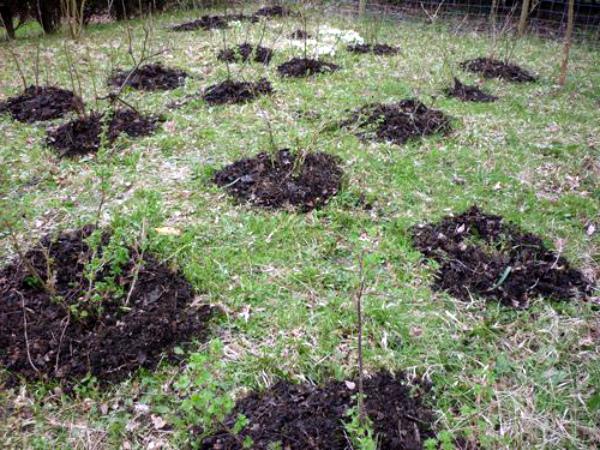
How to care for your culture
The Hinnomaki variety is quite unpretentious in care. It is not difficult to grow such a gooseberry even for summer residents who have no experience in gardening. For the plant to delight with berries, you need:
- Form bushes in time.
- Apply fertilizers.
- Conduct disease prevention.
The shrub bears fruit for a long time. The variety gives a stable harvest, but in regions where frosts exceed 30 ° C, the plant is recommended to be insulated for the winter.

Watering
The gooseberry can withstand drought well, but when it lasts long, the shrub needs irrigation. However, excess moisture in the ground should not be allowed, as this is fraught with root rot. Water the plant when the ovary is laid, the fruits ripen in the fall in preparation for winter.It is not recommended to irrigate gooseberries with a hose; it is better to dig a hollow and supply water to it.
Fertilizers
If, during planting, the holes were filled with humus and mineral complexes, the gooseberries can be fed only after a year. The variety needs a lot of potassium. In autumn, it is advised to bring under the bush:
- compost - half a bucket;
- superphosphate - 2 tablespoons;
- wood ash - 0.5 cups.
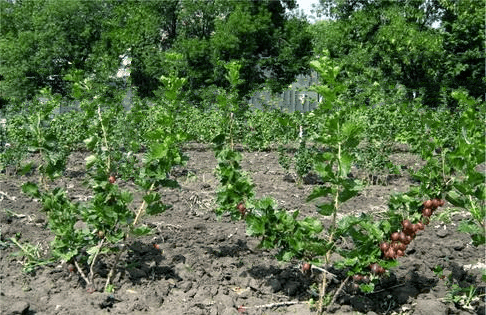
During flowering, during the period of fruit growth, organic matter is used. Every year the shrub is fertilized with ammonium nitrate. After watering, rains and fertilizing, the soil under the plant is loosened, since the earth is taken up by the crust and does not allow air to reach the roots.
Formation
One of the conditions necessary for harvesting large berries is the regular and correct pruning of gooseberries. In the spring, until the buds have opened, or in the fall, 1.5–2 months before the onset of frost, branches 5–6 years old that bear little fruit, are shortened to stumps or removed completely.
Every year, up to 5 shoots are left from new root growths, which are evenly spaced, all others are cut out. Sick and damaged gooseberry stems must be disposed of.
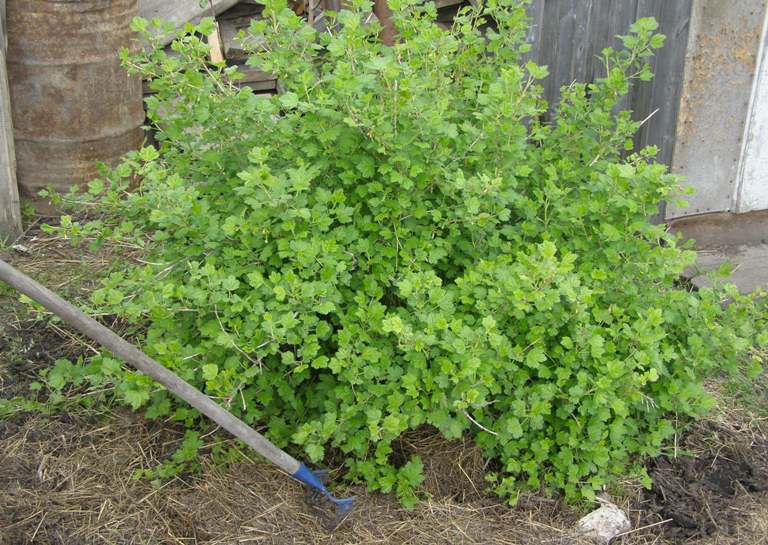
Treatment against diseases and pests
The Hinnomaki variety is immune to various types of powdery mildew. In adverse weather conditions, lack of care, fungi are activated, which cause:
- anthracnose;
- white spot;
- gray rot;
- goblet rust.
Gooseberries suffer from mosaics. The causative agent of the disease is a virus that is carried by aphids, as well as by grafting a shoot from an infected bush.
To prevent the multiplication of pathogenic microorganisms, in early spring the plants and the ground around them are sprayed with Nitrafen or treated with copper sulfate.
In autumn, the leaves are raked and burned along with dry branches. Anthracnose and white spot are dealt with using Bordeaux liquid, Kuprozan, colloidal sulfur.

To combat rust, gooseberries are treated with fungicides three times. Bushes infected with mosaics are dug up and immediately destroyed. Measures in the form of acquiring strong and healthy seedlings, treating gooseberries with insecticides that destroy insects help to avoid infection with the virus.
The bush attracts spider mites, moth, sawfly, is affected by currant gall midge and glassworm, attacks young shoots of aphids. In order not to fight parasites, using chemical preparations, gooseberries are poured with boiling water, then the leaves are raked and burned. The ground under the bushes is covered with roofing material, which is not removed until the plants have faded. During the period of bud formation, the bushes are treated with karbofos, which protects against aphids and gall midges. Kidney mites are destroyed by spraying the shoots with colloidal sulfur.
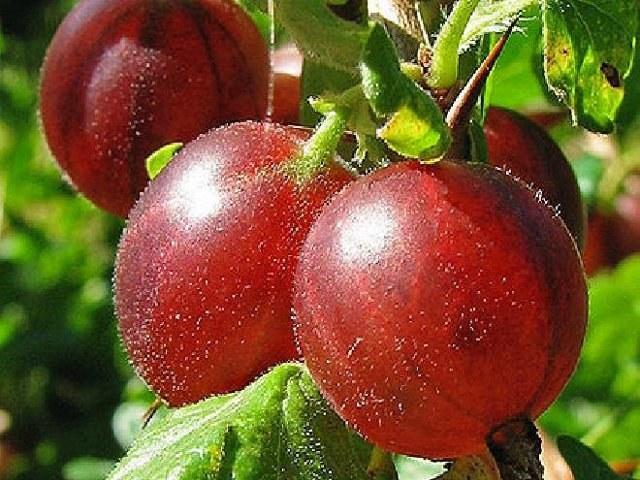
Breeding methods
Gooseberry Hinnomaki is bred by cuttings, dividing the bush. Seeds are used to create a new variety. To breed the plant with layering, before bud break 3 or 4 root shoots are selected, the tops are cut off, grooves 20 cm deep are dug on both sides of the bush. Branches are laid in them. The layers are attached with hairpins, when the buds sprout, they are sprinkled with earth, The formed young shoots 15 centimeters long are sprinkled with soil.
Bushes for propagation are divided into parts along with the roots in October or early spring and planted on the site.
Gooseberry harvesting and storage
Gardeners pick the berries of a thorny bush together with tails with their bare hands or wearing long mittens and suede gloves. The work is performed only on a dry day so that there is no dew. Gooseberry fruits are scattered in a thin layer, but they lie no more than 10 days. At 0 ° C, berries do not spoil for 2 months, in a small frost they are stored for up to 12 weeks in a sealed container.
